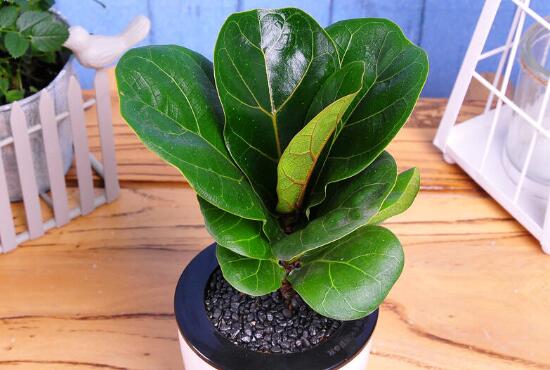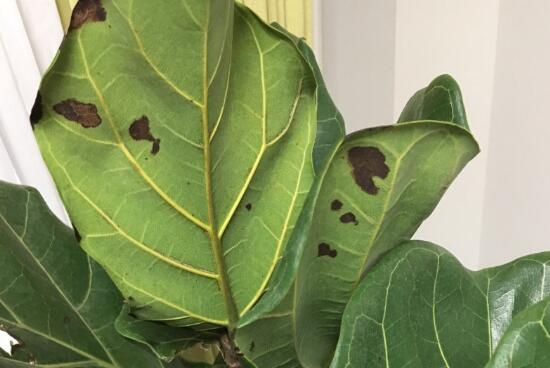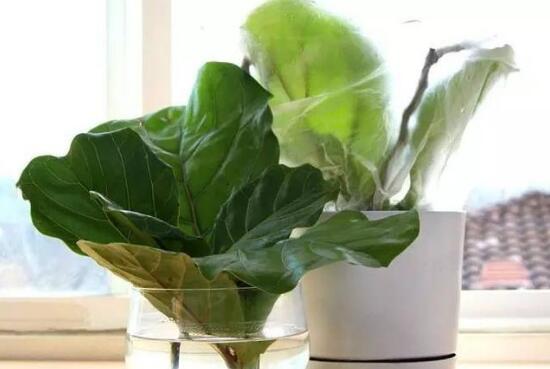How to apply fertilizer to Banyan banyan? how often is it fertilized / once every 10 days in growing season
As a beautiful foliage plant, the leaves of figs are very large and evergreen all the year round. In order to maintain the beauty of its leaves, adequate nutrients are very important, so fertilization is a very key link in the process of cultivating figs. So how to fertilize the banyan leaves? How often is the banyan leaf fertilized? Today, the editor is here to solve this problem for everyone.
First, how to fertilize the banyan, the method is very important

"A flower in a crop is dominated by fertilizer." although Qin leaf banyan is not beautiful to blossom, its leaves are large and green, and only with adequate fertilization can it be evergreen all the year round. However, fertilization, like watering, is a technical activity, and the frequency and amount of fertilization should be well controlled. So there are skills in how to fertilize Qin Ye banyan, and let's move on to the details.
Second, how often is the banyan leaf fertilized?
1. Seedling stage
How often the banyan is fertilized depends on its growth. First of all, in the first month of the seedling stage, the plant does not need much fertilizer, in order to its better growth, can be combined with watering a small amount of fertilizer. As for the choice of fertilizer, flower friends can use a lot of flowers, pay attention to the concentration of fertilizer must be light.
2. After the seedling stage
In the first three months after the seedling stage, the plant has become visible and needs to be fertilized gradually. As for how often the banyan is fertilized, it can be fertilized every half a month, and the concentration of fertilizer can be slightly thicker than that in the first month. At this time, in addition to spending a lot of fertilizer, we can also use potassium nitrate and calcium nitrate to use at the same time.
3. Growth period
When it comes to the growing period of Ficus chinensis, the plant grows faster and requires a large amount of fertilizer. at this time, how often do banyan trees apply fertilizer? we can keep it every one to two weeks. The choice of fertilizer is the same as above. After applying fertilizer, the leaves of Banyan will be thicker, greener and brighter.
4. Mature period
When the leaves of figs are fully unfolded, it is generally in August in summer, when the interval of fertilization should be kept at about 10 days, and the fertilizer is mainly nitrogen fertilizer. After the end of autumn, fertilizer should be suspended, no fertilizer should be applied throughout the winter, and fertilization should be suspended during the dormant period.
III. Matters needing attention in fertilization of Ficus chinensis
For beginners, when fertilizing the banyan, there is often too much fertilizer, so what should we do at this time? At this time, everyone should water the banyan tree thoroughly and let the current bring out the fertilizer. At the same time, move the plant to a ventilated and cool place and let it recover slowly. Do not start fertilizing until the temperature is above 20 ℃.
With regard to the fertilization method of Qin Ye Banyan, the editor has introduced this. After reading it, everyone should have more confidence in cultivating Qin Ye Banyan. Generally speaking, the cultivation method of Ficus chinensis is not difficult, but it is difficult in some details, whether it is watering or fertilization, it must be in the right amount, neither more nor less. Only in this way can you raise a basin of beautiful banyan leaves!
How to fertilize Qin Ye banyan?
How to fertilize the banyan leaves
The main results are as follows: 1. The growth rate of Ficus chinensis is faster than that of other similar plants. in the first month of seedling stage, there is little demand for fertilizer. A small amount of fertilizer can be used, combined with watering, once to twice, and fertilizer can be used with a lot of flowers. pay attention to the concentration of fertilizer must be light.
2. From the second month to the fifth month, there is already a tree shape, and it is getting bigger and bigger. At this time, it is necessary to gradually increase the amount of fertilizer, fertilizing once every half a month, and the concentration of fertilizer can be slightly thicker than that of the first month. Fertilizer can be used with potassium nitrate + Huaduo + calcium nitrate at the same time. Calcium and potassium in fertilizer is very helpful to the Lignification of stems.
3. The largest amount of fertilizer is needed in the growing season, which is fertilized almost every one to two weeks, which can make the leaves thicker, greener and brighter. Fertilizer can also be used with potassium nitrate + Huaduo + calcium nitrate at the same time.
4. After the new leaves are fully unfolded, the time is about the middle of August, then fertilization should be carried out every 10 days, and nitrogen fertilizer can be used as the main fertilizer.
Matters needing attention
Under normal growth conditions, fertilization should be suspended at the end of the autumn show, no fertilizer should be applied throughout the winter, and fertilization should be suspended during the dormant period.
The Propagation method of potted Banyan Ficus how to raise it
Qin leaf banyan, also known as piano leaf rubber tree, is an evergreen tree plant of Moraceae and Ficus genus. It gets its name because the leaf apex is swollen in the shape of a violin. The plant type is tall, straight and unrestrained, the leaf is strange, and it has high ornamental value. It is often used as an ideal foliage plant in the hall, and it can also be used to decorate the hall or office. Let's take a look at how to grow potted fir leaves.
Growth habits of Ficus quinquefolia
Banyan is native to Sierra Leone to Morocco in West Africa, lowland rainforest, widely cultivated in tropical, subtropical, indoor and greenhouse. It is mainly produced in Guangdong, Hainan, Guangxi, Fujian, Hunan, Hubei, Jiangxi, Anhui, Zhejiang and other places in China. It likes warm, humid and sunny environment, the suitable temperature for growth is 25 ℃ to 35 ℃, dormancy is about 15 ℃, and more than 5 ℃ can survive the winter safely. The requirement for moisture is that it is better to be wet than dry.
The Propagation method of Banyan Ficus
1. Cutting: 1 / 2-year-old branches of Ficus quinquefolia were cut at 20 / 30 cm from the soil surface of the basin, and cut into 3 / 3 / 4 stem segments as cuttings, leaving a leaf in each cuttage, and the leaves were cut off 2 / 2 / 3 / 3 / 4 to reduce water evaporation. First soak the cuttings in water or touch the wounds with plant ash to prevent the sap from flowing out, insert the cuttings into the cutter made of river sand or perlite, and pay attention to keeping the temperature of the sowing bed and the high air humidity around it. It can take root in about one month at the temperature of 25-30 ℃.
2. High pressure: the high pressure propagation of Ficus chinensis can be carried out from April to August. Select the top branch of the upper half of the mother plant, leave 3 or 4 leaves on the upper part, peel or cut in the lower part of it, then wrap it with moss and bind it with plastic film. It can take root in about 40 days, and then it can be planted or pots when it grows to about 30 cm.
How to cultivate potted banyan leaves?
1. Potted soil: when potted, the basin with larger volume should be selected, and the pot should be changed every 2-3 years in spring. The bottom of the basin should be covered with tiles with convex surface, and then put on an old basin, and then a new substrate composed of pastoral soil, peat soil and a small amount of sandy soil should be added. The soil should be slightly acidic.
2. Fertilization: the leaves of Chin leaf banyan are broad and need a large amount of fertilizer, so liquid fertilizer or granular compound fertilizer should be applied in 1-2 weeks of growth and season to promote plant growth and thick green leaves, but no fertilizer is generally applied at the end of autumn and winter. From the opening of new leaves to the middle of August, fertilizer was applied every 10 days, mainly nitrogen fertilizer. When the growth is large, you can apply more fertilizer, stop growing or do not apply fertilizer when dormant.
3. Watering: the watering amount of Qin leaf banyan should depend on the temperature of the surrounding environment, the water demand in spring and summer is relatively large, and the amount of water should be reduced in the dormant period to keep the basin soil moist. Summer can properly shower light rain to facilitate growth, regular spraying of warm water, growth will be better, watering is also slightly acidic for better. Excessive temperature fluctuations or exposure to direct sunlight in the short term are not conducive to growth. If the plant is watered too much under low temperature for a long time, it can cause plant death.
4. Illumination: banyan has strong adaptability to light and can grow well under bright scattered light. Direct sunlight should be avoided in summer, and shade should be increased in winter if it is placed outside. Suitable for growing in semi-overcast environment, avoid direct sunlight in summer, so as not to burn the leaves and lose their luster. But the light is too weak and the growth of the plant is weak, so it must be given brighter light in order to grow healthily. The growing season generally grows well under 50% shade.
5. Temperature: compared with other banyan plants, Ficus chinensis has relatively weak cold tolerance, the suitable temperature for growth is 25 ℃ to 35 ℃, dormancy is about 15 ℃, and it can survive the winter safely above 5 ℃. In order to improve its cold resistance, in addition to controlling the amount of water in late autumn and winter, phosphorus and potassium fertilizer can be increased about one month before the coming of winter.
6. disease prevention: after the disease occurs, the banyan plant should be quickly moved to a place with sufficient sunlight and ventilation, do not spray water on the leaf surface, and cut off the seriously diseased leaves. Mildly diseased leaves can cut off the disease spot together with part of the healthy tissue, and then spray Duoduo solution to protect it, or spray 80% Dysen zinc wettable powder 500 times, 25% metalaxyl wettable powder 500 times, etc., pay attention to the rotational use of chemicals.
- Prev

What about the rust spots on the banyan leaves? the causes of the rust spots on the leaves of the banyan leaves / pay attention to water and temperature
Qin leaf banyan, a beautiful foliage plant, whose leaves are large and visible, looks like a cello, and is evergreen all the year round. But in the process of culture, many flower friends have rust spots on the leaves of figs, which seriously affects the ornamental quality of the plants. they would like to know what to do with the rust spots of figs.
- Next

Can banyan leaves be cultured in water? can banyan leaves be cultured in water / cut leaves in water?
As a common foliage plant, Qin leaf banyan is very effective, it is not only good-looking, can purify the air, but also can be used medicinally to treat diseases. Such plants are naturally raised at home by many people, but many flower lovers prefer water culture to soil cultivation. Can the fir leaf banyan be hydroponically cultivated? if possible
Related
- Fuxing push coffee new agricultural production and marketing class: lack of small-scale processing plants
- Jujube rice field leisure farm deep ploughing Yilan for five years to create a space for organic food and play
- Nongyu Farm-A trial of organic papaya for brave women with advanced technology
- Four points for attention in the prevention and control of diseases and insect pests of edible fungi
- How to add nutrient solution to Edible Fungi
- Is there any good way to control edible fungus mites?
- Open Inoculation Technology of Edible Fungi
- Is there any clever way to use fertilizer for edible fungus in winter?
- What agents are used to kill the pathogens of edible fungi in the mushroom shed?
- Rapid drying of Edible Fungi

